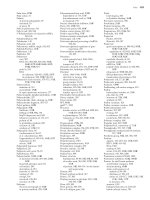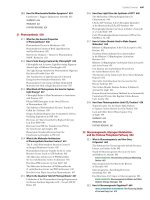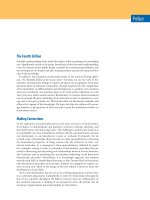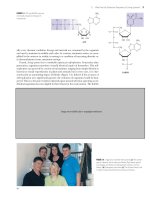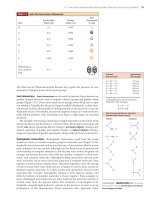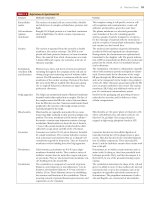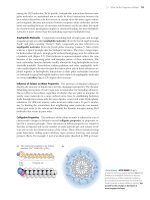Biochemistry, 4th Edition P75 pdf
Bạn đang xem bản rút gọn của tài liệu. Xem và tải ngay bản đầy đủ của tài liệu tại đây (702.94 KB, 10 trang )
23.2 How Are Fatty Acids Broken Down? 703
chain derivatives must first be converted to acylcarnitine derivatives, as shown in
Figure 23.8. Carnitine acyltransferase I, associated with the outer mitochondrial
membrane, catalyzes the formation of the O-acylcarnitine, which is then trans-
ported across the inner membrane by a translocase. At this point, the acylcarni-
tine is passed to carnitine acyltransferase II on the matrix side of the inner mem-
brane, which transfers the fatty acyl group back to CoA to re-form the fatty
acyl-CoA, leaving free carnitine, which can return across the membrane via the
translocase.
Several additional points should be made. First, although oxygen esters usually
have lower group-transfer potentials than thiol esters, the OOacyl bonds in acyl-
carnitines have high group-transfer potentials, and the transesterification reactions
mediated by the acyltransferases have equilibrium constants close to 1. Second,
note that eukaryotic cells maintain separate pools of CoA in the mitochondria and
in the cytosol. The cytosolic pool is utilized principally in fatty acid biosynthesis (see
Chapter 24), and the mitochondrial pool is important in the oxidation of fatty acids
and pyruvate, as well as some amino acids.
N
+
CH
3
CH
3
CH
3
CO
O
CH
CH
2
CH
2
CH
2
O-acylcarnitine
CO
O
CH
CH
2
CH
2 CH
2
COO
–
COO
–
COO
–
S
C
O
SH
N
+
H
3
CCH
3
CH
3
N
+
H
3
CCH
3
CH
3
HHO C
CoA
CoA
H
HO C
C
OO
–
S
C O
SH
CH
2
CH
2
N
+
CH
3
CH
3
CH
3
CoA
CoA
Intermembrane
space
Inner
mitochondrial
membrane
Outer
mitochondrial
membrane
Mitochondrial
matrix
Carnitine: acylcarnitine
translocase
O-acylcarnitine
L-Carnitine
Carnitine
acyltrans-
ferase II
Cytosol
L-Carnitine
Intermembrane
space
Carnitine
acyltrans-
ferase I
FIGURE 23.8 The formation of acylcarnitines and their
transport across the inner mitochondrial membrane.
The process involves the coordinated actions of carni-
tine acyltransferases on both the inner and outer mito-
chondrial membranes and of a translocase that shuttles
O-acylcarnitines across the inner membrane.
704 Chapter 23 Fatty Acid Catabolism
-Oxidation Involves a Repeated Sequence of Four Reactions
For saturated fatty acids, the process of -oxidation involves a recurring cycle of
four steps, as shown in Figure 23.9. The overall strategy in the first three steps is to
create a carbonyl group on the -carbon by oxidizing the C
␣
OC

bond to form an
olefin, with subsequent hydration and oxidation. In essence, this cycle is directly
analogous to the sequence of reactions converting succinate to oxaloacetate in the
TCA cycle. The fourth reaction of the cycle cleaves the -keto ester in a reverse
Claisen condensation, producing an acetate unit and leaving a fatty acid chain that
is two carbons shorter than it began. (Recall from Chapter 19 that Claisen con-
densations involve attack by a nucleophilic agent on a carbonyl carbon to yield a
-keto acid.)
A Family of Acyl-CoA Dehydrogenases Carry Out the First Reaction of -Oxidation
The enzymes of mitochondrial -oxidation are organized in two functional systems:
a membrane-bound complex that is specific for long-chain fatty acids (14 carbons
and longer) and a family of soluble enzymes in the matrix that is specific for
short- and medium-chain fatty acids (Figure 23.10). As a fatty acyl chain is shortened
in successive cycles of -oxidation, it moves from the membrane-bound complex to
the family of soluble matrix enzymes. The first reaction of the -oxidation cycle is
catalyzed by one of four acyl-CoA dehydrogenases. These include the very long-
OH
C
CH
2
H
2
O
RCC S
H
HH
O
C SCH
2
R
O
C
CH
2
RCC S
H
H
O
O
C
CH
2
RCCS
H
H
O
HO
CCH
2
RCC S
H
H
H
␣
␣


␣

O
C C S
H
H
H
␣

␣

1
2
3
4
CoA
CoA
CoA
CoA
CoA
CoA
Fatty acyl-CoA
Fatty acyl-CoA
shortened by two carbons
-Ketoacyl-CoA
trans-Δ
2
-Enoyl-CoA
L--H
y
drox
y
ac
y
l-CoA
FAD
FADH
2
Acyl-CoA
dehydrogenase
Enoyl-CoA
hydratase
HydrationOxidation
+
L-Hydroxyacyl-CoA
dehydrogenase
Thiolase
Acetyl-CoA
Cleavage Oxidation
Successive cycles
H
+
CoASH
NAD
+
NADH
FIGURE 23.9 The -oxidation of saturated fatty acids involves a cycle of four enzyme-catalyzed reactions. Each
cycle produces single molecules of FADH
2
, NADH, and acetyl-CoA, consumes a water, and yields a fatty acid
shortened by two carbons. (The delta [⌬] symbol connotes a double bond, and its superscript indicates the
lower-numbered carbon involved.)
23.2 How Are Fatty Acids Broken Down? 705
chain acyl-CoA dehydrogenase (VLCAD), as well as acyl-CoA dehydrogenases spe-
cific for long-chain (LCAD), medium-chain (MCAD), and short-chain (SCAD) sub-
strates. VLCAD is a membrane-bound homodimer of 67-kD subunits (Figure 23.11),
whereas the soluble LCAD, MCAD, and SCAD are homotetramers of 40- to 45-kD
subunits.
All acyl-CoA dehydrogenases carry noncovalently (but tightly) bound FAD, which
is reduced during the oxidation of the fatty acid. As shown in Figure 23.12, FADH
2
transfers its electrons to an electron transfer flavoprotein (ETF). Reduced ETF is re-
oxidized by a specific oxidoreductase (an iron–sulfur protein), which in turn sends
the electrons on to the electron-transport chain at the level of coenzyme Q. Recall
from Chapter 20 that mitochondrial oxidation of FAD in this way eventually results
in the net formation of about 1.5 ATPs. The mechanism of the acyl-CoA dehydroge-
nase (Figure 23.13) involves deprotonation of the fatty acid chain at the ␣-carbon, fol-
lowed by hydride transfer from the -carbon to FAD.
LCAD
MCAD
SCAD
ECHKT
ECH
KTHAD
HAD
VLCAD
SCoAR
O
SCoA
CoA
R
O
SCoAR
O
SCoAH
3
C
O
FIGURE 23.10 Very long-chain fatty acids proceed through several cycles of -oxidation (left) via membrane-
bound enzymes in mitochondria. A membrane-bound multifunctional complex includes the enoyl-CoA hydra-
tase (ECH), hydroxyacyl-CoA dehydrogenase (HAD), and ketoacyl thiolase (KT) activities. As chains shorten pro-
gressively, they become substrates for the separate, soluble enzymes of -oxidation (right).
(a) (b)
FIGURE 23.11 (a) The VLCAD of mammalian mitochondria is a 67-kD membrane-bound homodimer with
bound FAD (red) and myristoyl-CoA (blue) (pdb id ϭ 3B96).The tertiary structure of the N-terminal 400
residues of VLCAD is similar to that of (b) the soluble MCAD (pdb id ϭ 3MDE), shown with bound FAD (red)
and octanoyl-CoA (blue).These similar structures each include an N-terminal ␣-helical domain (yellow), fol-
lowed by a -sheet domain (blue) and another ␣-helical domain (green).The acyl-CoA substrate lies in a long
cleft between these three domains.The VLCAD also has a C-terminal ␣-helical domain (purple).
706 Chapter 23 Fatty Acid Catabolism
Enoyl-CoA Hydratase Adds Water Across the Double Bond The next step in
-oxidation is the addition of the elements of H
2
O across the new double bond in a
stereospecific manner, yielding the corresponding hydroxyacyl-CoA.
The reaction is catalyzed by enoyl-CoA hydratase (Figure 23.14). A number of dif-
ferent enoyl-CoA hydratase activities have been detected in various tissues. Also
called crotonases, these enzymes specifically convert trans-enoyl-CoA derivatives to
L--hydroxyacyl-CoA. Enoyl-CoA hydratases will also metabolize cis-enoyl-CoA (at
slower rates) to give specifically
D--hydroxyacyl-CoA. In addition, there is a novel
enoyl-CoA hydratase that converts trans-enoyl-CoA to
D--hydroxyacyl-CoA.
L-Hydroxyacyl-CoA Dehydrogenase Oxidizes the -Hydroxyl Group The third
reaction of this cycle is the oxidation of the hydroxyl group at the -position to
produce a -ketoacyl-CoA derivative. This second oxidation reaction is catalyzed
by
L-hydroxyacyl-CoA dehydrogenase, an enzyme that requires NAD
ϩ
as a coen-
zyme (see Figure 23.9).
CH
2
SCoA
R
CH
2
R
CC
H
CH
H
OH
C
CH
2
C
O
O
SCoA
H
2
O
trans-Enoyl-CoA
Crotonase
L--Hydroxyacyl-CoA
R CH
2
H
C
β
C
α
C SCoA
H
HHO
UQH
2
UQ
R CH
2
H
CCC SCoA
HO
1.5 ADP
1.5 P
i
1.5
+
ATP
O
2
H
2
O
Fatty acyl-CoA
Acyl-CoA
dehydrogenase
FAD
FADH
2
ETF
red
ETF
ox
ETF: UQ
oxidoreductase
ox
ETF: UQ
oxidoreductase
red
Mitochondrial
electron-
transport
chain
1
2
trans-Δ
2
-Enoyl-CoA
FIGURE 23.12 The acyl-CoA dehydrogenase reaction.The two electrons removed in this oxidation reaction are
delivered to the electron-transport chain in the form of reduced coenzyme Q (UQH
2
).
CCH
2
H
R
H
C
H
H
CCH
2
H
R
H
C
HO
C SCoA
O
C
SCoA
FAD
CH
2
R
CC
H
H
B
O
C
SCoA
E
FIGURE 23.13 The mechanism of acyl-CoA dehydrogenase. Removal of a proton from the ␣-C is followed by
hydride transfer from the -carbon to FAD.
(a)
(b)
(c)
FIGURE 23.14 Structures of mitochondrial (a) enoyl-
CoA hydratase trimer (pdb id ϭ 2DUB), (b) hydroxyacyl-
CoA dehydrogenase dimer (pdb id ϭ 1F0Y), and
(c) ketoacyl thiolase dimer (pdb id ϭ 1AFW).
(a)
(b)
(c)
23.2 How Are Fatty Acids Broken Down? 707
NADH produced in this reaction represents metabolic energy. Each NADH pro-
duced in mitochondria by this reaction drives the synthesis of 2.5 molecules of ATP
in the electron-transport pathway.
L-Hydroxyacyl-CoA dehydrogenase shows ab-
solute specificity for the
L-hydroxyacyl isomer of the substrate. (D-Hydroxyacyl
isomers, which arise mainly from the metabolism of unsaturated fatty acids, are
handled differently.)
-Ketoacyl-CoA Intermediates Are Cleaved in the Thiolase Reaction The final
step in the -oxidation cycle is the cleavage of the -ketoacyl-CoA. This reaction,
catalyzed by ketoacyl thiolase (also known as -ketothiolase, Figure 23.9), involves
the attack of a cysteine thiolate from the enzyme on the -carbonyl carbon, fol-
lowed by cleavage to give the enolate of acetyl-CoA and an enzyme-thioester
intermediate (Figure 23.15). Subsequent attack by the thiol group of a second CoA
and departure of the cysteine thiolate yields a new (shorter) acyl-CoA. If the
reaction in Figure 23.15 is read in reverse, it is easy to see that it is a Claisen
condensation—an attack of the enolate anion of acetyl-CoA on a thioester. Despite
the formation of a second thioester, this reaction has a very favorable K
eq
, and it
drives the three previous reactions of -oxidation.
Repetition of the -Oxidation Cycle Yields a Succession
of Acetate Units
In essence, this series of four reactions has yielded a fatty acid (as a CoA ester) that
has been shortened by two carbons and one molecule of acetyl-CoA. The shortened
fatty acyl-CoA can now go through another -oxidation cycle, as shown in Figure 23.9.
Repetition of this cycle with a fatty acid with an even number of carbons eventually
yields two molecules of acetyl-CoA in the final step. Complete -oxidation of palmitic
CCH
2
H
R
OH
C
O
CCH
2
RCH
2
C
O
SCoACH
2
O
SCoA
L--Hydroxyacyl-CoA -Ketoacyl-CoA
H
+
+
NAD
+
NADH
O
–
C
C
O
CH
2
O
R
+
S
–
BH
E
R
C
S
BH
+
+
H
O
S
S CoA
R
C
B
BH
O
S
R
C
C
CCH
2
SCoA
SCoA
C
R
S
E
S
–
CH
2
C
H
3
C
SCoA
C
O
R
SCoA
SCoA
CoA
+
O
–
C
SCoA
CH
2
O
–
O
E
E
O
O
E
-Ketoacyl-CoA
Acyl-CoA
FIGURE 23.15 The mechanism of the thiolase reaction. Attack by an enzyme cysteine thiolate group at the
-carbonyl carbon produces a tetrahedral intermediate, which decomposes with departure of acetyl-CoA,
leaving an enzyme thioester intermediate. Attack by the thiol group of a second CoA yields a new (shortened)
acyl-CoA.
Go to CengageNOW and click
CengageInteractive to discover the main functions
of coenzyme A.
708 Chapter 23 Fatty Acid Catabolism
acid yields eight molecules of acetyl-CoA as well as seven molecules of FADH
2
and
seven molecules of NADH (Figure 23.16 and Table 23.2). The acetyl-CoA can be
further metabolized in the TCA cycle (as we have already seen). Alternatively,
acetyl-CoA can also be used as a substrate in amino acid biosynthesis (see Chapter
25). As noted in Chapter 22, however, acetyl-CoA cannot be used as a substrate for
gluconeogenesis.
Complete -Oxidation of One Palmitic Acid Yields
106 Molecules of ATP
If the acetyl-CoA is directed entirely to the TCA cycle in mitochondria, it can eventu-
ally generate approximately ten high-energy phosphate bonds—that is, ten molecules
of ATP synthesized from ADP (Table 23.2). Including the ATP formed from FADH
2
and NADH, complete -oxidation of a molecule of palmitoyl-CoA in mitochondria
HUMAN BIOCHEMISTRY
Exercise Can Reverse the Consequences of Metabolic Syndrome
Metabolic syndrome is a combination of disorders that increase the
risk of diabetes and cardiovascular disease. The hallmarks of meta-
bolic syndrome include high blood pressure, elevated serum
triglycerides, reduced serum high-density lipoprotein (HDL) cho-
lesterol, insulin resistance, and obesity. The prevalence of these
conditions is increasing in the United States. By most estimates,
more than 30% of Americans are obese, and rising obesity has con-
tributed to an epidemic of type 2 diabetes. Insights into how the
body deals with high fat and high sugar diets are emerging from a
variety of studies, and evidence points clearly to the benefits of ex-
ercise and dietary restriction. Endurance training (such as distance
running) and resistance training (with weights) are both benefi-
cial. Endurance training increases the mass of slow-twitch muscle
fibers, resistance training builds fast-twitch muscle fibers, and both
types of exercise reduce body fat, but in quite different ways.
Slow-twitch muscles depend on fatty acid oxidation and TCA
cycle activity to support long periods of exercise and are termed
oxidative. Effects of endurance training include increased expres-
sion of (1) peroxisome proliferator-activated receptor ␦, a tran-
scription factor that builds slow-twitch muscle fiber, and (2) in-
sulin receptors and glucose transporters. Fast-twitch muscles are
adapted for short bursts of energy, which can be supplied by gly-
colysis and thus are termed glycolytic. Effects of resistance training
include activation of metabolic processes by the serine/threonine
kinase Akt1. Induction of the Akt1 pathway results in growth of
fast-twitch skeletal muscle fibers and subsequent effects on several
other organs. These include increased fat uptake and oxidation by
the liver and heart, reduction of adipose (fat cell) mass, and re-
duced blood glucose and insulin levels.
Local effects in muscle:
Increased fatty acid
oxidation
Increased expression of
insulin receptors and
glucose transporters
Adipose tissue:
Reduced
cell size
Circulation:
Reduced glucose,
insulin, and
le
p
tin levels
Muscle:
Increased glucose uptake
and glycolysis
Liver:
Increased fat
uptake and
oxidation
Heart:
Increased fat
uptake and
oxidation
Endurance training
Circulating
factors
Weight training
Fast-twitch
muscle growth
Slow-twitch
muscle growth
23.2 How Are Fatty Acids Broken Down? 709
yields 108 molecules of ATP. Subtracting the two high-energy bonds needed to form
palmitoyl-CoA, the substrate for -oxidation, one concludes that -oxidation of a mol-
ecule of palmitic acid yields 106 molecules of ATP. The ⌬G°Ј for complete combustion
of palmitate to CO
2
is Ϫ9790 kJ/mol. The hydrolytic energy embodied in 106 ATPs
is 106 ϫ 30.5 kJ/mol ϭ 3233 kJ/mol, so the overall efficiency of -oxidation under
standard-state conditions is approximately 33%. The large energy yield from fatty acid
oxidation is a reflection of the highly reduced state of the carbon in fatty acids. Sugars,
in which the carbon is already partially oxidized, produce less energy, carbon for car-
bon, than do fatty acids. The breakdown of fatty acids is regulated by a variety of
metabolites and hormones. Details of this regulation are described in Chapter 24, fol-
lowing a discussion of fatty acid synthesis.
Migratory Birds Travel Long Distances on Energy from Fatty
Acid Oxidation
Because they represent the most highly concentrated form of stored biological
energy, fatty acids are the metabolic fuel of choice for sustaining the incredibly
long flights of many migratory birds. Although some birds migrate over landmasses
and eat frequently, other species fly long distances without stopping to eat. The
American golden plover (Figure 23.17) flies directly from Alaska to Hawaii, a
3300-km flight requiring 35 hours (at an average speed of nearly 60 miles/hr) and
more than 250,000 wing beats! The ruby-throated hummingbird, which winters in
C SCoA
O
7 CoA, 7
[
FAD
]
, 7 NAD
+
8 Acetyl-CoA
-Oxidation
Electron
transport
Oxidative
phosphorylation
24 NADH, 8
[
FADH
2
]
16 CO
2
8 ATP
TCA
cycle
7
[
FADH
2
]
, 7 NADH + 7 H
+
100 ADP + 100 P
i
100 ATP
FIGURE 23.16 Reduced coenzymes produced by -oxidation and TCA cycle activity provide electrons that
drive the synthesis of ATP in oxidative phosphorylation. Complete oxidation of palmitoyl-CoA yields a total of
108 ATP.Subtracting the 2 ATP equivalents consumed in forming the original CoA thioester, oxidation of palmi-
tate produces 106 ATP.
ATP Free Energy
Equation Yield Yield (kJ/mol)
CH
3
(CH
2
)
14
CO-CoA ϩ 7 [FAD] ϩ 7 H
2
O ϩ 7 NAD
ϩ
ϩ 7 CoA
88n
8 CH
3
CO-CoA ϩ 7 [FADH
2
] ϩ 7 NADH ϩ 7 H
ϩ
7 [FADH
2
] ϩ 10.5 P
i
ϩ 10.5 ADP ϩ 3.5 O
2
88n
7 [FAD] ϩ 17.5 H
2
O ϩ 10.5 ATP 10.5 320
7 NADH ϩ 7 H
ϩ
ϩ 17.5 P
i
ϩ 17.5 ADP ϩ 3.5 O
2
88n
7 NAD
ϩ
ϩ 24.5 H
2
O ϩ 17.5 ATP 17.5 534
8 Acetyl-CoA ϩ 16 O
2
ϩ 80 ADP ϩ 80 P
i
88n
8 CoA ϩ 88 H
2
O ϩ 16 CO
2
ϩ 80 ATP 80 2440
CH
3
O(CH
2
)
14
CO-CoA ϩ 108 P
i
ϩ 108 ADP ϩ 23 O
2
88n
108 ATP ϩ 16 CO
2
ϩ 123 H
2
O ϩ CoA 108 3294
Energetic “cost” of forming palmitoyl-CoA from palmitate and CoA Ϫ2 Ϫ61
Total 106 3233
TABLE 23.2
Equations for the Complete Oxidation of Palmitoyl-CoA to CO
2
and H
2
O
710 Chapter 23 Fatty Acid Catabolism
Central America and nests in southern Canada, often flies nonstop across the Gulf
of Mexico. These and similar birds accomplish these prodigious feats by storing large
amounts of fatty acids (as triacylglycerols) in the days before their migratory flights.
The percentage of dry-weight body fat in these birds may be as high as 70% when mi-
gration begins (compared with values of 30% and less for nonmigratory birds).
Fatty Acid Oxidation Is an Important Source of Metabolic Water
for Some Animals
Large amounts of metabolic water are generated by -oxidation (123 H
2
O per
palmitoyl-CoA, see Table 23.2). For certain animals—including desert animals
(such as gerbils) and killer whales (which do not drink seawater)—the oxidation of
fatty acids can be a significant source of dietary water. A striking example is the
camel (Figure 23.17), whose hump is essentially a large deposit of fat. Metabolism
of fatty acids from this store provides needed water (as well as metabolic energy)
during periods when drinking water is not available. It might well be said that “the
ship of the desert” sails on its own metabolic water!
23.3 How Are Odd-Carbon Fatty Acids Oxidized?
-Oxidation of Odd-Carbon Fatty Acids Yields Propionyl-CoA
Fatty acids with odd numbers of carbon atoms are rare in mammals but fairly common
in plants and marine organisms. Humans and animals whose diets include these food
sources metabolize odd-carbon fatty acids via the -oxidation pathway. The final prod-
(a) Gerbil
(b) Ruby-throated hummingbird
(c) Golden
p
lover
(d) Orca
(e) Camels
FIGURE 23.17 Animals whose existence is strongly dependent
on fatty acid oxidation: (a) gerbil, (b) ruby-throated humming-
bird, (c) golden plover, (d) orca (killer whale), and (e) camels.
Photo Researchers, Inc.
© Millard H. Sharp/Photo Researchers, Inc.
© Eric and David Hosking/CORBIS
© Francois Gohier/Photo Researchers, Inc.
© George Holton/Photo Researchers, Inc.
23.3 How Are Odd-Carbon Fatty Acids Oxidized? 711
uct of -oxidation in this case is the three-carbon propionyl-CoA instead of acetyl-
CoA. Three specialized enzymes then carry out the reactions that convert propionyl-
CoA to succinyl-CoA, a TCA cycle intermediate. (Because propionyl-CoA is a degra-
dation product of methionine, valine, and isoleucine, this sequence of reactions is
also important in amino acid catabolism, as we shall see in Chapter 25.) The pathway
involves an initial carboxylation at the ␣-carbon of propionyl-CoA to produce
D-methylmalonyl-CoA (Figure 23.18). The reaction is catalyzed by a biotin-dependent
enzyme, propionyl-CoA carboxylase. The mechanism involves ATP-driven carboxyla-
tion of biotin at N
1
, followed by nucleophilic attack by the ␣-carbanion of propionyl-
CoA in a stereospecific manner.
D-Methylmalonyl-CoA, the product of this reaction, is converted to the
L-isomer by methylmalonyl-CoA epimerase (Figure 23.18). (This enzyme has often
and incorrectly been called “methylmalonyl-CoA racemase.” It is not a racemase
because the CoA moiety contains five other asymmetric centers.) The epimerase
reaction involves a carbanion at the ␣-position formed via a reversible dissociation
of the acidic ␣-proton (Figure 23.19). The
L-isomer is the substrate for methyl-
malonyl-CoA mutase. Methylmalonyl-CoA epimerase is an impressive catalyst. The
pK
a
for the proton that must dissociate to initiate this reaction is approximately 21!
If binding of a proton to the ␣-anion is diffusion limited, with k
on
ϭ 10
9
M
Ϫ1
sec
Ϫ1
,
then the initial proton dissociation must be rate limiting and the rate constant
must be
k
off
ϭ K
a
и k
on
ϭ (10
Ϫ21
M) и (10
9
M
Ϫ1
sec
Ϫ1
) ϭ 10
Ϫ12
sec
Ϫ1
The turnover number of methylmalonyl-CoA epimerase is 100 sec
Ϫ1
, and thus the
enzyme enhances the reaction rate by a factor of 10
14
.
A B
12
-Catalyzed Rearrangement Yields Succinyl-CoA
from
L-Methylmalonyl-CoA
The third reaction, catalyzed by methylmalonyl-CoA mutase, is quite unusual be-
cause it involves a migration of the carbonyl-CoA group from one carbon to its
neighbor (Figure 23.18). The mutase reaction is vitamin B
12
–dependent and begins
with homolytic cleavage of the Co
3ϩ
OC bond in 5Ј-deoxyadenosylcobalamin, re-
ducing the cobalt to Co
2ϩ
(see A Deeper Look, page 712). Transfer of a hydrogen
atom from the substrate to the deoxyadenosyl group produces a methylmalonyl-
CoA radical, which then can undergo a classic B
12
-catalyzed rearrangement to yield
SCoA
O
+CH
3
CH
2
C ++
H
2
O
ATP
CH
2
CH
2
C
C
H
3
C
H
3
C
O
_
OOC
_
OOC
_
OOC
C
SCoA
O
C
H
H
C
SCoA
O
SCoA
CO
2
Propionyl-CoA
Methylmalonyl-Co
A
mutase
Succinyl-CoA
L-Methylmalonyl-CoA
Methylmalonyl-Co
A
epimerase
D-Methylmalonyl-CoA
Propionyl-CoA
carboxylase
FIGURE 23.18 The conversion of propionyl-CoA (formed
from -oxidation of odd-carbon fatty acids) to succinyl-
CoA is carried out by a trio of enzymes, as shown.
Succinyl-CoA can enter the TCA cycle.
O
C
–
O
2
C C
CH
3
H
B
O
C
–
O
2
C C
H
H
3
C
B
O
–
C
–
O
2
C
C
CH
3
CH
3
HO
–
C
–
O
2
CCSCoA
B
H
B
SCoA
SCoA
SCoA
E
E
E
E
(S)-Methylmalonyl-CoA (R)-Methylmalonyl-CoA
Resonance-stabilized carbanion intermediate
FIGURE 23.19 The methylmalonyl-CoA epimerase mechanism involves a resonance-stabilized carbanion at the
␣-position.
712 Chapter 23 Fatty Acid Catabolism
a succinyl-CoA radical. Hydrogen transfer from the deoxyadenosyl group yields
succinyl-CoA and regenerates the B
12
coenzyme (see problem 16 at the end of the
chapter).
Net Oxidation of Succinyl-CoA Requires Conversion to Acetyl-CoA
Succinyl-CoA derived from propionyl-CoA can enter the TCA cycle. Oxidation of
succinate to oxaloacetate provides a substrate for glucose synthesis. Thus, al-
though the acetate units produced in -oxidation cannot be utilized in gluco-
neogenesis by animals, the occasional propionate produced from oxidation of
odd-carbon fatty acids can be used for sugar synthesis. Alternatively, succinate in-
troduced to the TCA cycle from odd-carbon fatty acid oxidation may be oxidized
to CO
2
. However, all of the four-carbon intermediates in the TCA cycle are re-
generated in the cycle and thus should be viewed as catalytic species. Net con-
sumption of succinyl-CoA thus does not occur directly in the TCA cycle. Rather,
the succinyl-CoA generated from -oxidation of odd-carbon fatty acids must be
converted to pyruvate and then to acetyl-CoA (which is completely oxidized in the
TCA cycle). To follow this latter route, succinyl-CoA entering the TCA cycle must
be first converted to malate in the usual way and then transported from the mi-
tochondrial matrix to the cytosol, where it is oxidatively decarboxylated to pyru-
vate and CO
2
by malic enzyme, as shown in Figure 23.20. Pyruvate can then be
transported back to the mitochondrial matrix, where it enters the TCA cycle via
pyruvate dehydrogenase. Note that malic enzyme plays a role in fatty acid synthe-
sis (see Figure 24.1).
A DEEPER LOOK
The Activation of Vitamin B
12
Conversion of inactive vitamin B
12
to active 5Ј-deoxyadenosylcobalamin
involves three steps (see accompanying figure). Two flavoprotein
reductases sequentially convert Co
3ϩ
in cyanocobalamin to the
Co
2ϩ
state and then to the Co
ϩ
state. Co
ϩ
is an extremely power-
ful nucleophile. It attacks the C-5Ј carbon of ATP as shown, expel-
ling the triphosphate anion to form 5Ј-deoxyadenosylcobalamin.
Because two electrons from Co
ϩ
are donated to the CoOcarbon
bond, the oxidation state of cobalt reverts to Co
3ϩ
in the active
coenzyme. This is one of only two known adenosyl transfers (that
is, nucleophilic attack on the ribose 5Ј-carbon of ATP) in biologi-
cal systems. (The other is the formation of S-adenosylmethionine;
see Chapter 25.)
ATP
CH
2
12
3
N
N
N
N
N
N
CH
3
CH
3
Inactive Vitamin B
12
(Co
3+
)
(cyanocobalamin)
Flavoprotein
reductases
Supernucleophile (Co
+
)
O
O
P
–
OO
O
P
O
P
O
–
O
–
O
–
OCH
2
O
OH OH
N
N
N
N
NH
2
CN
N
N
N
N
N
N
CH
3
CH
3
DMBz
Co
+
Co
3+
N
N
N
N
CH
2
O
OH
OH
Reactive
free radical
O
OH OH
N
N
N
N
AA
Co
3+
Co
2+
5-Deoxyadenosyl-cobalamin
(one of several B
12
coenzyme forms)
ᮡ
Formation of the active coenzyme 5Ј-deoxyadenosylcobalamin from inactive vitamin B
12
is initiated
by the action of flavoprotein reductases. The resulting Co
ϩ
species, dubbed a supernucleophile, attacks
the 5Ј-carbon of ATP in an unusual adenosyl transfer. Homolytic cleavage of the Co
3+
–C bond produces
a reactive free radical that facilitates rearrangements such as that in the methylmalonyl-CoA mutase
reaction.
